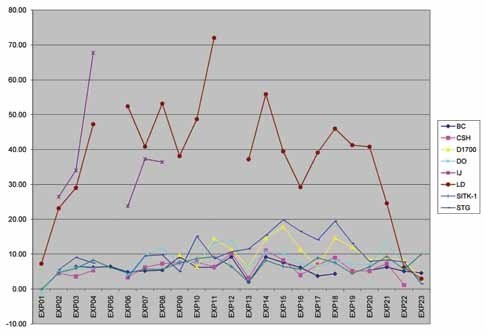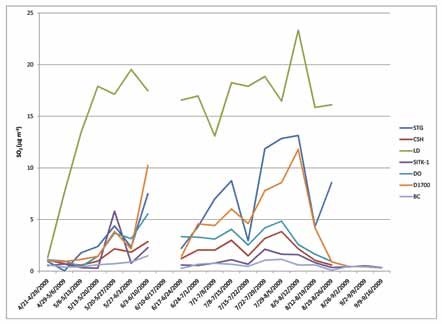Last updated: October 26, 2021
Article
Effects of Cruise Ship Emissions on Air Quality and Terrestrial Vegetation in Southeast Alaska

Photo courtesy of Alaska Department of Environmental Conservation.
Abstract
Increased tourism in Southeast Alaska has raised concerns about the levels and ecological effects of air pollutants emitted by cruise ships in dock and in transit. A multi-agency, regional monitoring program is in place to measure regional and local air pollutants accumulated by vegetation and in deposition. Early results suggest that nitrogen and sulfur oxides, and deposition of sulfur, lead, zinc and vanadium are elevated in Klondike Gold Rush National Historical Park (KLGO) and the adjacent Skagway municipality. Nitrogen and sulfur deposition were elevated at Sitka National Historical Park. Ten-year re-measurements from KLGO and Skagway provide evidence of increasing nitrogen and decreasing lead and nickel deposition, consistent with increased cruise ship port time and the discontinuation of uncontained mining ore transfers in Skagway harbor. Strongest pollution zones correspond with highest human population densities.
Introduction
Increased cruise-ship tourism in Southeast Alaska has been accompanied by increasing concerns about air pollution (Furbish et al. 2000). Combustion of low-grade marine fuels releases nitrogen and sulfur oxides, poly-cyclic aromatic hydrocarbons, and metals(Graw et al., this issue). In Skagway, frequent summer inversions prevent dispersal of emissions from in port operation of diesel and bunker fuel generators, resulting in noticeable haze and odors (Figure 1). Ships in transit in the narrow fjords of Glacier Bay National Park and Preserve (GLBA) and Tracy Arm-Fords Terror Wilderness of the Tongass National Forest (TNF) also produce visible plumes. Recently, managers of the TNF, GLBA, Klondike Gold Rush National Historical Park (KLGO), The Municipality of Skagway, and Sitka National Historical Park (SITK) combined resources to establish monitoring plots designed to assess status of and trends in air quality and detect ecological effects on sensitive epiphytic vegetation due to air pollution. Cruise ship emissions are dominant pollution sources at all sites.

Methods
Monitoring was conducted for air pollution concentration, deposition, precipitation chemistry, and vegetation response. Ogawa passive samplers (Figure 2) were used to measure ambient concentrations of nitrogen oxide, ammonia and sulfur dioxide gases. Canopy throughfall samplers were used to measure precipitation chemistry of nitrate, ammonium and sulfate ions. Total deposition was characterized from elemental analysis of epiphytic lichens (Figure 3), which was compared to clean site ranges for nitrogen, sulfur, and metals. Community surveys of epiphytic lichens were conducted to assess status of sensitive species. Elemental analysis data were compared to TNF baselines (Dillman et al. 2007); managers at this forest have maintained a network of about 120 permanent air quality biomonitoring plots since 1989 (Geiser et al. 1994).


Results
Work is still on-going but some initial results can be reported.• Nitrogen oxides were elevated and five to ten times higher in KLGO at Icy Junction and in the Municipal-ity of Skagway along the lower Dewey Lakes Trail compared to GLBA and SITK (Figure 4). Sulfur dioxide was elevated in Skagway along Dewey Lakes trail and at Sturgill’s Landing but not at other sites.
• The increase in ship traffic over the past ten years is correlated with small increases in nitrogen accumulated in epiphytic vegetation (lichens) at sites close to Skagway harbor (Figure 6).
• Sulfur levels associated with adverse effects to sensitive plants were primarily observed in KLGO lichens within 1.2 miles (2 km) of Skagway and at SITK (Figure 5).
• Lead, nickel, cadmium, and zinc levels in lichens were within background ranges at most sites, but still strongly elevated at KLGO sites closest to the Skagway harbor, a legacy from historic use of the harbor to transfer lead and zinc ore from open rail cars and trucks to barges (Figures 5-6).
• Vanadium, a product of diesel combustion, was very high at sites closest to the Skagway harbor, especially on the forested fjord walls along Dewey Lakes Trail above the harbor (Figure 6).

Figure 4 Part 2.
• Locally, pollution levels decreased rapidly with distance from point sources (i.e., port activity in Skagway and Sitka). Because the most impacted areas coincide with densest population centers, human health impacts are a potential concern. Lead, nickel and vanadium were significantly enhanced in KLGO/Skagway. Although sulfer and nitrogen oxides were elevated at KLGO/Skagway, they were below levels known to cause direct human health or phytotoxic impacts. However, indirect effects on plant community composition (e.g., from acidic deposition of nitrogen and sulfur compounds) are possible where clean site ranges were exceeded (KLGO/Skagway and SITK).
• The Western Airborne Contaminants Assessment Program study (Landers et al. 2008) reported elevated concentrations of nitrogen and certain polycyclic aromatic hydrocarbons (PAHs), both products of combustion, in lichens and conifer needles at Beartrack Cove, GLBA. Elevated nitrogen deposition is spotty as 2008 lichen nitrogen levels at Bartlett Cove, GLBA were within expected clean-site ranges; other pollutants were also within expected clean site ranges. More work is needed to understand pollutants and their depositional patterns in GLBA.
• Increasing nitrogen levels in epiphytic vegetation in KGLO/Skagway correlates with increasing nitrogen oxides from cruise ship emissions and tourism. Although greater trans-Pacific emissions associated with industrial expansion and energy production in Asia and more wildfires emissions from northern Alaska/Canada could contribute to background regional nitrogen oxide levels, nitrogen accumulated by epiphytes from TNF background sites did not increase significantly. Sources contributing to elevated ammonium sulfates in fine particulates at the Petersburg, Alaska, IMPROVE monitoring during the past 10 years have not been identified. As evidenced by the continuing widespread distribution of sensitive epiphytes across the TNF (Dillman 2004), there is as yet no evidence of blanket adverse ecological effects from nitrogen or sulfur deposition in Southeast Alaska.

Nickel, lead, and vanadium were very high at KLGO and Skagway sites closest to the harbor. Horizontal lines indicate clean-site thresholds for the Tongass National Forest established by Dillman et al. 2007.
Management Implications
• Reducing cruise ship emissions would have beneficial effects on visitor experiences of visibility and odor. In Skagway, it would also reduce potential human health effects from combustion-related air pollut-ants such as fine particulates, PAHs, and metals.• Because pollutant concentrations fall off rapidly with distance from sources, the worst impacts can be expected in locations close to docking areas or where topographic and meteorological conditions frequently combine to trap emissions close to the ground.
• Nitrogen and sulfur containing pollutants are quickly processed compared to many met-als, which have a much longer residence time (decades vs. years) in soils and vegetation.
• Continued monitoring of established sites can be used to verify effectiveness of air resource management policies. It could be important to measure particulate matter levels because nitrogen oxides, sulfur dioxide and ammonia form sulfate and nitrate aerosols which are hazardous to inhale and are precursors of acidic deposition.

By contrast, nitrogen increased slightly at most sites and sulfur declined at all sites except the site closest to the Skagway terminal. Horizontal lines indicate clean-site thresholds for the Tongass National Forest established by Dillman et al. 2007.
Acknowledgements
We thank the NPS Southeast Alaska Inventory and Monitoring Program, NPS Air Resources Division, NPS Southeast Alaska Coastal Cluster, Municipality of Skagway, US Forest Service Alaska Region Air Resource Management Program, and the Tongass National Forest Wilderness Management Program for providing funding for this project. Many competent field technicians and staff from Southeast Alaska contributed to making this project a success. Most of all, the partnership between the US Forest Service and the National Park Service made this work possible.For further info, please visit: http://gis.nacse.org/lichenair
References
Dillman, K. 2004.
Epiphytic Lichens from the Forest-Marine Ecotone of Southeastern Alaska. Master’s Thesis. Arizona State University, Tempe.
Dillman, K., L. Geiser, and G. Brenner. 2007.
Air Quality Biomonitoring with Lichens, Tongass National Forest. US Forest Service report, Petersburg, Alaska.
Furbish, C.E., L. Geiser, and C. Rector. 2000.
Lichen-air quality pilot study for Klondike Gold Rush National Historical Park and the City of Skagway, Alaska. National Park Service. Skagway, Alaska.
Geiser, L.H., C.C. Derr, and K.L. Dillman. 1994.
Air Quality Monitoring on the Tongass National Forest Methods and Baselines Using Lichens. R10TB46. Alaska Region, USDA Forest Service.
Landers, D.H., S.L. Simonich, D.A. Jaffe, L.H. Geiser, D.H. Campbell, A.R. Schwindt, C.B. Schreck, M.L. Kent, W.D. Hafner, H.E. Taylor, K.J. Hageman, S. Usenko, L.K. Ackerman, J.E. Schrlau, N.L. Rose, T.F. Blett, and M.M. Erway. 2008.
The Fate, Transport, and Ecological Impacts of Airborne Contaminants in Western National Parks (USA). EPA/600/R-07/138. U.S. Environmental Protec-tion Agency, Office of Research and Development, NHEERL, Western Ecology Division. Corvallis, Oregon.
Tags
- glacier bay national park & preserve
- klondike gold rush national historical park
- sitka national historical park
- glba
- klgo
- glacier bay national park
- klondike gold rush national historical park
- marine traffic
- visitor use
- air quality
- plant communities
- plants animals and more
- alaska
- alaska park science
- aps
- aps vol 9 iss 2
- ak1
